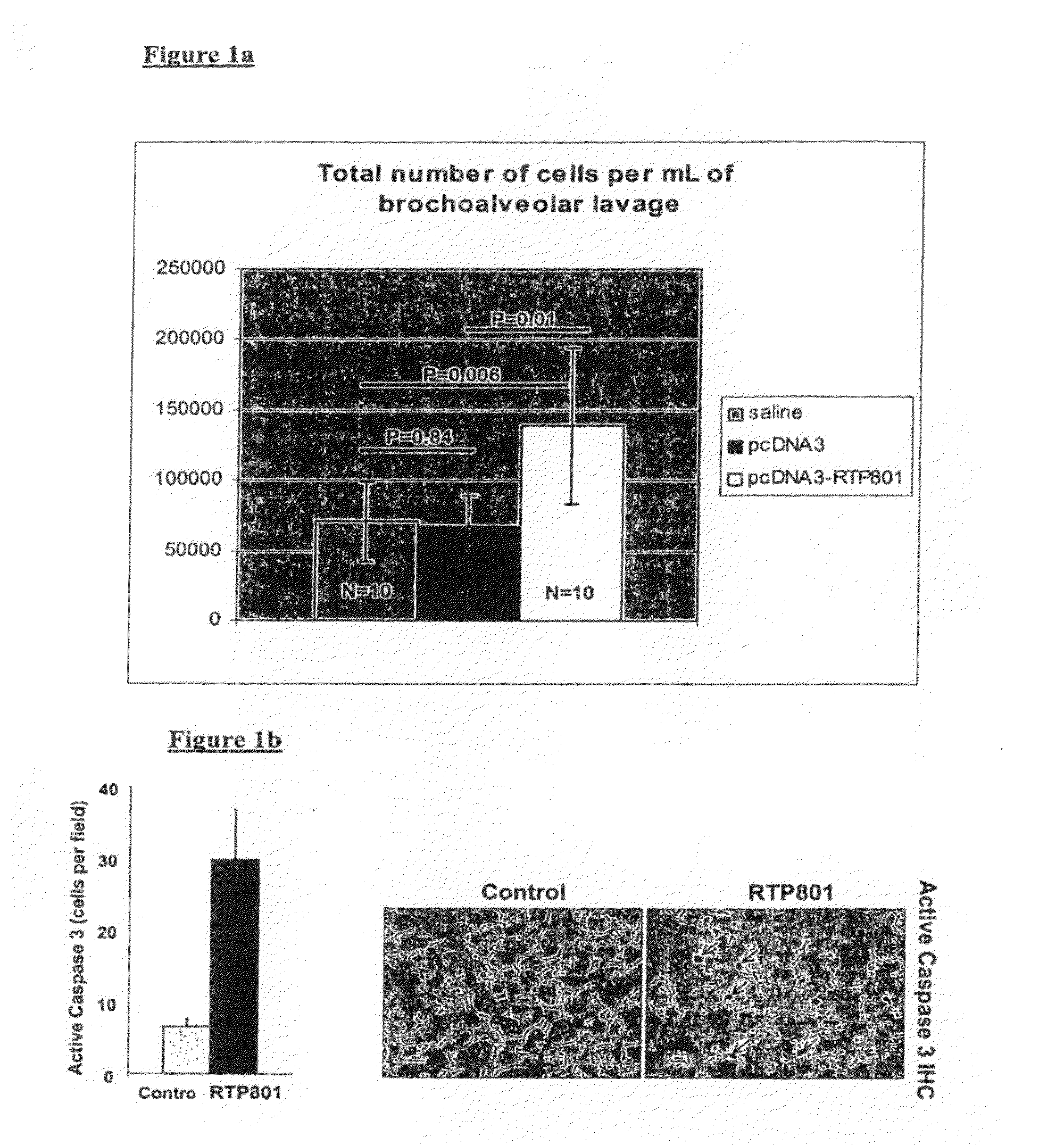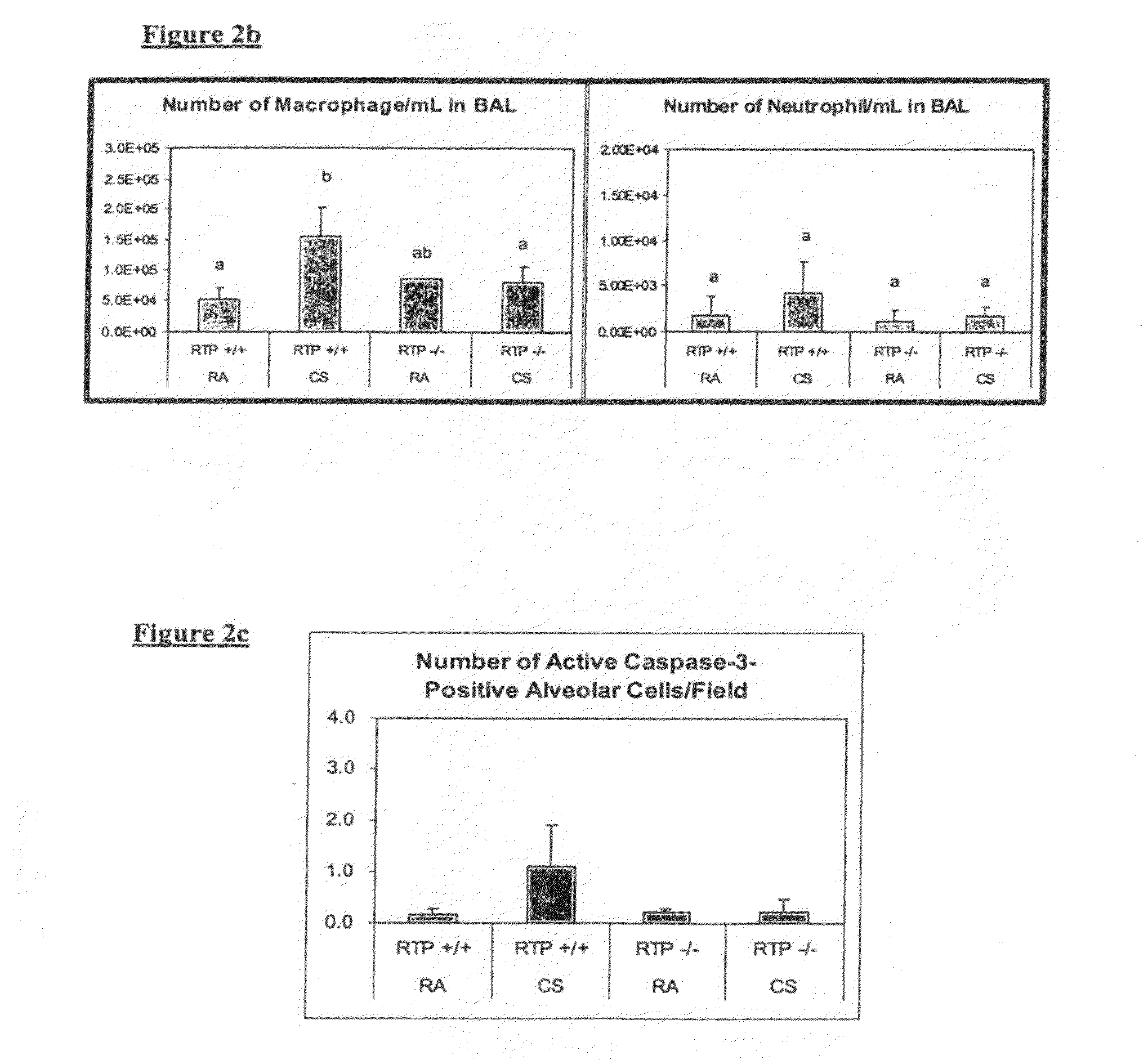Therapeutic delivery of inhibitory nucleic acid molecules to the respiratory system
a nucleic acid and respiratory system technology, applied in the field of respiratory disorders, can solve the problems of increasing the intrapulmonary oxidant burden, the difficulty of systemic administration of potential therapeutics, and the poor standard treatment, so as to inhibit the expression of p53 in the lung, inhibit the expression of rtp801 in the lung, and inhibit the expression of gene expression
- Summary
- Abstract
- Description
- Claims
- Application Information
AI Technical Summary
Benefits of technology
Problems solved by technology
Method used
Image
Examples
example 1
Models and Results Relating to COPD and Emphysema
[0097]As indicated below, an exemplary siRNA (termed REDD14) in aqueous solution directed against gene RTP801 (see co-assigned patent publication No WO06 / 023544A2 and co-assigned application No. PCT / US2007 / 01468 which are hereby incorporated by reference in their entirety) was tested in the following animal models:[0098]Cigarette smoke-induced emphysema model: chronic exposure to cigarette smoke causes emphysema in several animals such as, inter alia, mouse, guinea pig.[0099]Lung protease activity as a trigger of emphysema.[0100]VEGFR inhibition model of emphysema.[0101]Bronchial instillation with human neutrophil / pancreatic elastase in rodents.[0102]MMP (matrix metalloprotease)-induced enphysema.[0103]Inflammation-induced emphysema.
[0104]Additionally, emphysema models may be generated through genetic means (e.g., mice carrying the TSK mutation), and emphysematous animals may be generated by known modifiers of susceptibility to emphys...
example 2
Pharmacokinetics and Tissue Distribution of siRNA (REDD14Cy3.5 and I5NP) in Cynomolgus Monkeys Following Single Oronasal Inhalation Administration of a Nebulised Aerosol Formulation
Summary
[0130]Male cynomolgus monkeys were administered single oronasal inhalation doses of a nebulised aerosol formulation of fluorescent-labelled REDD14Cy3.5 and / or I5NP siRNAs. Following dosing, the concentration of I5NP in plasma, the non-compartmental disposition kinetics of I5NP in plasma, the qualitative distribution of REDD14Cy3.5 in lungs and the semi-quantitative distribution of I5NP in lungs were determined.
[0131]Sequence of siRNAs used in the study:
REDD14Cy3.5SenseGUGCCAACCUGAUGCAGCUAntisenseAGCUGCAUCAGGUUGGCAC15NPSenseGAGAAUAUUUCACCCUUCAAntisenseUGAAGGGUGAAAUAUUCUC
[0132]REDD14 is an exemplary RTP801 inhibiting siRNA; I5NP is an exemplary p53 inhibiting siRNA.
[0133]Three separate dose treatments were administered to the animals as detailed below. The theoretical inhalation achieved doses of siR...
example 3
Effect of Nrf2 siRNA Pulmonary Administration on Tumor Growth In Vivo
Methods:
[0197]Tumor Xenografts: A549 cells (5×106) were injected into the hind leg of male athymic nude mice and the tumor was measured weekly. The tumor volumes were measured using the following formula: [length (mm)×width (mm)×width (mm)×0.52]. In the lung metastasis experiments, 2×106 A549-C8-luc cells were injected into SCID-Beige mice (Charles River, Mass.) intravenously.
[0198]For in vivo experiments, all siRNA compounds were chemically synthesized being stabilized by alternating 2-O′-Me modifications on both strands. The sequence of siRNA targeting human Nrf2 used for in vivo experiments is 5′-UCCCGUUUGUAGAUGACAA-3′ (sense) and 5′-UUGUCAUCUACAAACGGGA-3′ (antisense). The sequence of control siRNA targeting GFP is 5′-GGCUACGUCCAGGAGCGCACC-3′ (sense) and 5′-GGUGCGCUCCUGGACGUAGCC-3′ (antisense).
[0199]For lung tumor delivery, female C57B6 mice were injected with Lewis Lung Carcinoma (LLC) cells (0.5×106) intraveno...
PUM
| Property | Measurement | Unit |
|---|---|---|
| particle size | aaaaa | aaaaa |
| diameter | aaaaa | aaaaa |
| diameter | aaaaa | aaaaa |
Abstract
Description
Claims
Application Information
 Login to View More
Login to View More - R&D
- Intellectual Property
- Life Sciences
- Materials
- Tech Scout
- Unparalleled Data Quality
- Higher Quality Content
- 60% Fewer Hallucinations
Browse by: Latest US Patents, China's latest patents, Technical Efficacy Thesaurus, Application Domain, Technology Topic, Popular Technical Reports.
© 2025 PatSnap. All rights reserved.Legal|Privacy policy|Modern Slavery Act Transparency Statement|Sitemap|About US| Contact US: help@patsnap.com



